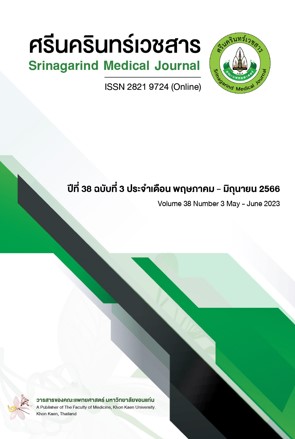Antepartum and Intrapartum Risk Score to Recognize Birth Asphyxia After Delivery
Keywords:
birth asphyxia, apgar score, labor, delivery, risk factors, prognosisAbstract
Background and objective: Birth asphyxia is the main factor for fatality in neonatal. The evaluation of the risk factors and the prediction of birth asphyxia during the antepartum and intrapartum periods could potentially reduce the rate of the incidence. This evaluation aimed to study the characteristics of the risk factors and to create the risk scoring system targeting birth asphyxia from the risk factors identified during antepartum and intrapartum.
Materials and methods: The study was a case-control prognostic prediction research. The data was collected retrospectively from the electronic medical record and the delivery summary at Maharat Nakhon Ratchasima hospital’s labor room from January 1st 2018 - December 31st, 2019. The inclusion criteria of the participants include the patients who delivered at 28 weeks gestation and birth weight was greater than or equal to 1,000 grams, with no significant birth defects or death. The subjects were separated into: (1) the mother who gave birth with birth asphyxia (case; apgar score ≤7) 300 subjects, and (2) the mother who gave birth without birth asphyxia (control; apgar score >7) 1,279 subjects. The data was analyzed with multivariable logistic regression and the coefficient was calculated into the clinical risk score.
Results: The factors to predict birth asphyxia were gestational age, antenatal care, gestational diabetes mellitus, severe preeclampsia, antepartum hemorrhage, multifetal pregnancy, the fetus in positions other than head-first, meconium strain, polyhydramnios, oligohydramnios and nonreassuring NST. Results showed that the area under the curve (AuROC) was 82.2% (95% CI;79.1, 85.4). The clinical risk scores were categorized according to the likelihood ratio of positive (LHR+) for birth asphyxia. In the low-risk group (risk score < 3.5), LHR+ for birth asphyxia was 0.27 (95%CI; 0.02,0.37). In the moderate risk (risk score 3.5 - 13) the LHR+ was 1.37 (95% CI; 1.08,1.73), and the high-risk group (risk score > 13) showed 18.25 LHR+ (95% CI; 11.55, 29.63).
Conclusion: Pregnant women with the antepartum and intrapartum risk score more than 13 have a 18.25 times higher risk of birth asphyxia. Additional care and close monitoring of this group of patients are warranted to decrease the occurrence of birth asphyxia.
References
Groenendaal F, Bel FV. Perinatal asphyxia in term and late preterm infants [Internet]. uptodate.com. 2019 [updated 2021 Oct 25; cite March 1, 2023]. Available from: https://www.uptodate.com/contents/perinatal-asphyxia-in-term-and-late-preterm-infants.
Lawn JE, Cousens S, Zupan J. 4 million neonatal deaths: when? where? why? Lancet 2005;365(9462):891-900. doi: 10.1016/S0140-6736(05)71048-5
Committee on Obstetric Practice American Academy of Pediatrics - Committee on Fetus and Newborn. Committee opinion No.644:the Apgar score. Obstet Gynecol 2015;126(4):e52-5. doi:10.1097/AOG.0000000000001108
World Health Organization. International Statistical Classification of Diseases and Related Health Problems 10th Revision (ICD-10)-WHO Version for 2016, Chapter XVI Certain conditions originating in the perinatal period (P00-P96) Respiratory and cardiovascular disorders specific to the perinatal period (P20-P29) [Internet]. Geneva. World Health Organization; 2016 [cited 2023 March 1]. Available from: https://icd.who.int/browse10/2016/en#/XVI.
Puernngooluerm P. Factors influenced birth asphyxia in term pregnancies at Maharat Nakhon Ratchasima Hospital. Med J Srisaket Surin Buriram 2010;25(3):265-78.
Wayessa ZJ, Belachew T, Joseph J. Birth asphyxia and associated factors among newborns delivered in Jimma zone public hospitals, Southwest Ethiopia: a cross-sectional study. J Midwifery Reproductive Health 2018;6(2):1289-95. doi: 10.22038/JMRH.2018.10483
Sattayaruk S, Luengratsameerung S, Wiriyasirivaj B, Phaloprakarn C. Antepartum and intrapartum risk factors associated with low one-minute Apgar score: a case-control study. Thai J Obstet Gynaecol 2014;22(3):118-27.
Majeed R, Memon Y, Majeed F, Shaikh NP, Rajar UD.Risk factors of birth asphyxia. J Ayub Med Coll Abbottabad 2007;19(3):67-71. PMID: 18444595
Tasew H, Zemicheal M, Teklay G, Mariye T, Ayele E. Risk factors of birth asphyxia among newborns in public hospitals of Central Zone, Tigray, Ethiopia 2018. BMC Res Notes 2018;11(496):1-7. doi: 10.1186/s13104-018-3611-3
Suwannachat B. Risk factors for birth asphyxia in Kalasin Hospital. Srinagarind Med J 2004; 19(4):233-40.
Panna S. Risk factors for birth asphyxia in newborns delivered at Nongkhai hospital. Srinagarind Med J 2020;35(3):278-86.
Williams J, Cunningham F, Leveno K, Bloom S, Spong C, Dashe J. Willium obstetrics. 25th ed. United States: Mc Graw Hill Education; 2018.
Pitsawong C, Panichkul P. Risk factors associated with birth asphyxia in Phramongkutklao Hospital. RTA Med J 2011;64(3):109-19.
Berhe YZ, Kebedom AG, Gebregziabher L, Assefa NE, Berhe LZ, Mohammednur SA, et al. Risk factors of birth asphyxia among neonates born in Public Hospitals of Tigray, Northern Ethiopia. Pediatric Health Med Ther 2020 Jan 8;11:13-20. doi: 10.2147/PHMT.S231290.
Saksangawong S, Rattanamongkolgul S. Risk factor and risk score for birth asphyxia in Kumpawapi Hospital, Udonthani Province. RTA Med J 2019;72(1):41-52.
Committee on Obstetric Practice. Committee Opinion No 689: delivery of a newborn with meconium-stained amniotic fluid. Obstet Gynecol 2017;129(3):e33-4. doi: 10.1097/AOG.0000000000001950.
Downloads
Published
How to Cite
Issue
Section
License
Copyright (c) 2023 Srinagarind Medical Journal

This work is licensed under a Creative Commons Attribution-NonCommercial-NoDerivatives 4.0 International License.




